| Up a level | ||||||||||
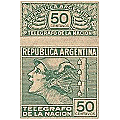 |
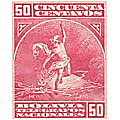 |
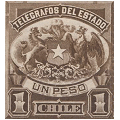 |
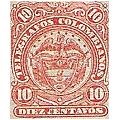 |
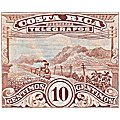 |
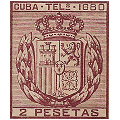 |
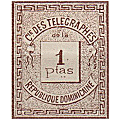 |
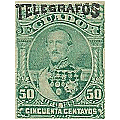 |
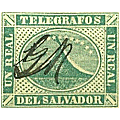 |
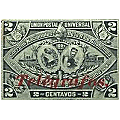 |
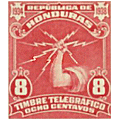 |
| Argentina | Bolivia | Chile | Colombia | Costa Rica | Cuba | Dominican Rep. | Ecuador | El Salvador | Guatemala | Honduras |
| Up a level | ||||||||||
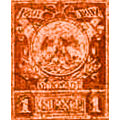 |
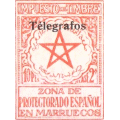 |
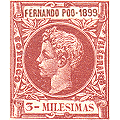 |
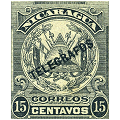 |
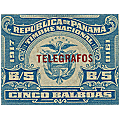 |
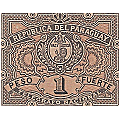 |
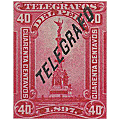 |
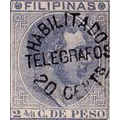 |
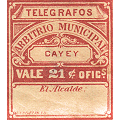 |
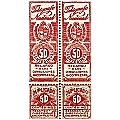 |
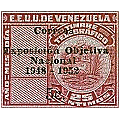 |
| Mexico | Morocco | Guinea | Nicaragua | Panama | Paraguay | Peru | Philippines | Puerto Rico | Uruguay | Venezuela |
I have brought these prices up to date and added currency selection. I have now re-numbered, but in line with what I have done with other countries, I am using RH numbers (Revised Hiscocks) for my numbering and also showing the original Hiscocks numbers. CheckList Setup |
| Shortcuts to different sections | |||||||
| Correos y Telégrafos - 1 | 1892 Overprints | Correos y Telégrafos - 2 | Loose Ends | 1907 | 1910 | 1927 | Telegram Seals |
Costa Rica .
Further information, together with later fiscal and other uses of overprinted telegraph stamps can be found in a
catalogue of stamps of Costa Rica, produced by Dr. Hector R. Mena and available from the Socorico website.
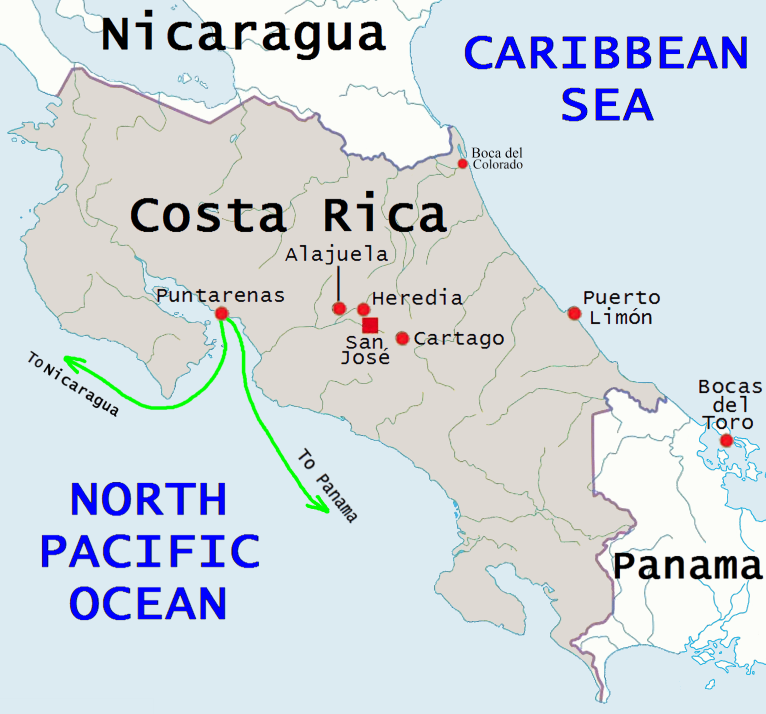
For 1889, 1892 and 1901 issues of normal 'Correos y Telégrafos' stamps were used and can be recognised by their concentric circle cancels.
I understand that after 1895 this cancel was also used as a postal cancellation.
1889 Various frames featuring the head of President Soto Alfaro and 'UPU'. Scott says Perf. 14-16 & Compound. Michel says Perf. 14 or 15 x 14. Yvert says Perf. 14-15.
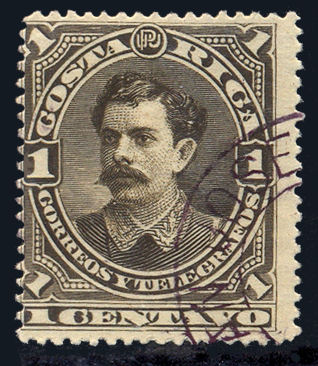 |
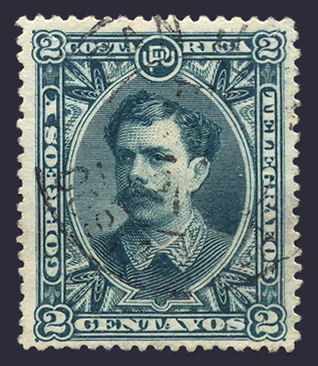 |
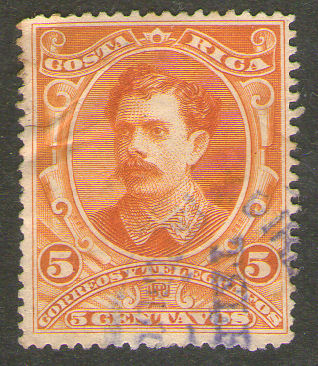 |
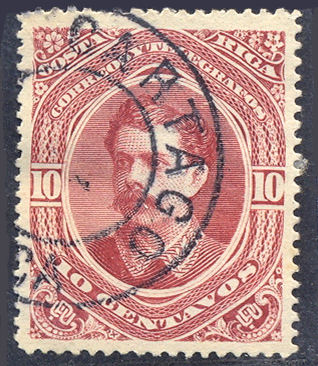 |
| 1c CyT stamp of 1889 from Rolf Lamprecht. | 2c CyT stamp of 1889 from Rolf Lamprecht. | 5c CyT stamp of 1889 series. | 10c CyT stamp of 1889 from Rolf Lamprecht. |
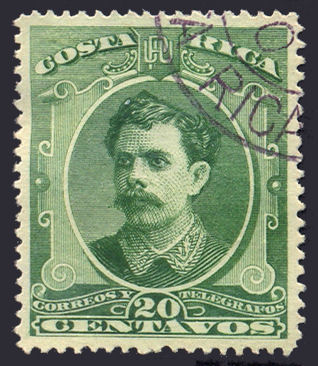 |
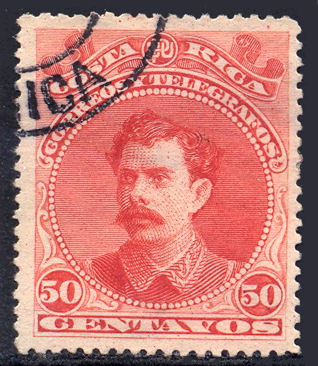 |
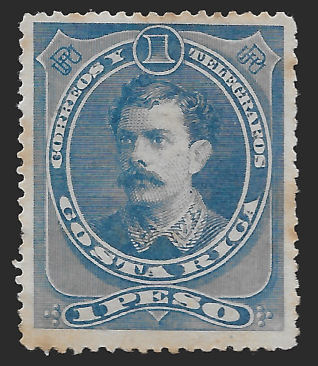 |
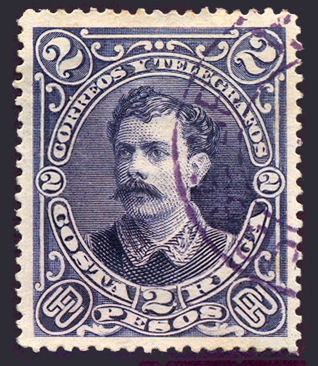 |
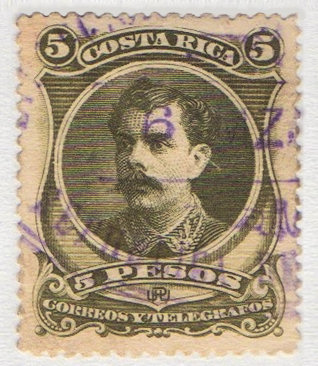 |
| 20c CyT stamp of 1889 from Rolf Lamprecht. | 50c CyT stamp of 1889 from Rolf Lamprecht. | 1P CyT stamp courtesy of Arkadiy Avrorov. | 2P CyT stamp of 1889 from Rolf Lamprecht. | 2P CyT stamp courtesy of Les & Paul Bottomley. |
| RH # | Description | Mint | Used | Postal/Telegraph used pricing |
|---|---|---|---|---|
| CT1 | 1c brown | 0.35 | 0.45 | postal |
| CT2 | 2c dark blue-green | 0.35 | 0.45 | postal |
| CT3 | 5c orange | 0.45 | 0.35 | postal |
| CT4 | 10c red-brown | 0.40 | 0.35 | postal |
| CT5 | 20c yellow-green | 0.30 | 0.35 | postal |
| CT6 | 50c rose-red | 1.00 | 0.75 | telegraph |
| CT7 | 1P blue (shades) | 1.25 | 0.75 | telegraph |
| CT8 | 2P dark violet (shades) | 6.00 | 4.00 | telegraph |
| CT9 | 5P olive-green | 25.00 | 10.00 | telegraph |
| CT10 | 10P black | 100.00 | 60.00 | telegraph |
10 similar designs showing President Soto Alfaro. According to the Scott Catalogue, the 5 highest values, 50c, 1p, 2p, 5p and 10p "normally were used on telegrams
and most copies were removed from the forms and sold by the government". Almost certainly they were sold to N. F. Seebeck who, as well as producing stamps for the
Hamilton Bank Note Co., was also a stamp dealer and was in Costa Rica early in 1889 to obtain a contract to supply stamps.
These stamps are known overprinted "GUANACASTE" for use in that sparsely populated province in the North-West, but there appears to have been no telegraph stations there, at least prior to 1912.
However, if those high values of the 1889 series were mostly telegraphically used, then the same may be true of the following series, but mostly the low values are seen and Scott makes no mention of it.
1892 Various frames featuring the arms of Costa Rica and 'UPU'. Scott says Perf. 12-15 & Compound. Michel says Perf. 15, 16 , 15 x 14 or 15 x 14½. Yvert says Perf. 15.
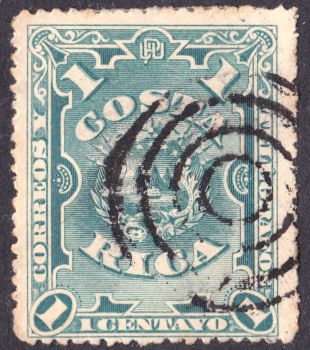
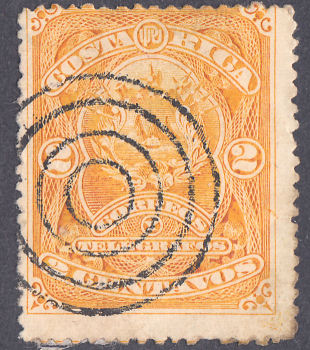
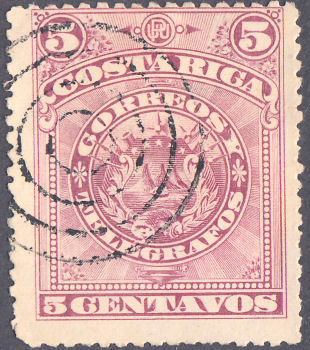
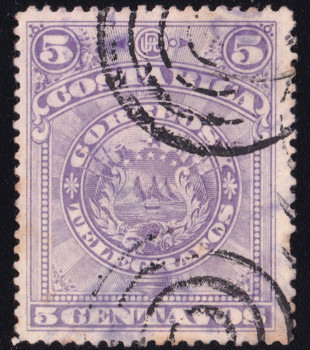
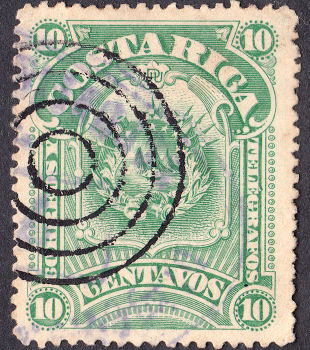
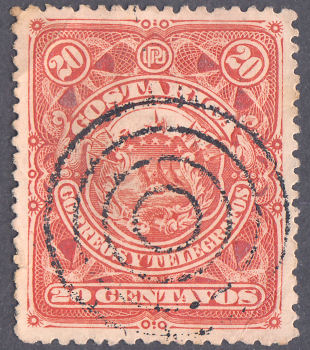

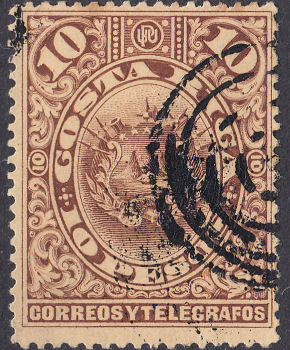
Correos y Telégrafos stamps of 1892 series (probably) used telegraphically. These stamps were used until 1901,
but the concentric circles cancellations started to be used postally from 1895.
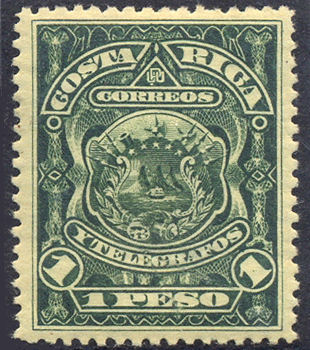
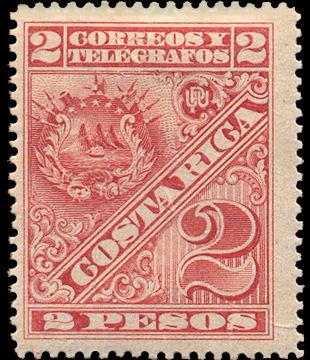
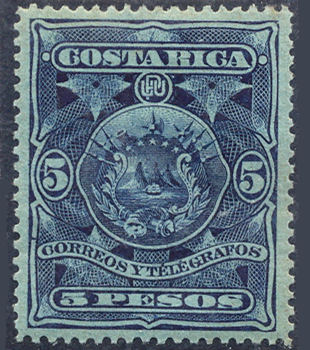
For the sake of completion, here are mint examples of the missing values courtesy of Rolf Lamprecht.
The 2 pesos is prone to darkening, probably due to sulpher compounds in the atmosphere.
| RH # | Description | Mint | Postally Used |
|---|---|---|---|
| CT11 | 1c light greenish blue | 0.30 | 0.40 |
| CT12 | 2c yellow | 0.30 | 0.40 |
| CT13 | 5c red lilac | 0.30 | 0.25 |
| CT13a | violet (SG34a) | 60.00 | 0.30 |
| CT14 | 10c light green | 0.75 | 0.35 |
| CT15 | 20c vermilion | 12.00 | 0.20 |
| CT16 | 50c light blue | 4.25 | 4.00 |
| CT17 | 1P dark green on yellow | 1.00 | 1.00 |
| CT18 | 2P red | 3.00 | 1.00 |
| CT19 | 5P dark blue on blue | 2.00 | 1.00 |
| CT20 | 10P brown on yellowish | 8.00 | 5.00 |
1892 'Correos y Telégrafos' stamps of 1892 (SG34a - 37) overprinted (by roller) 'TELEGRAFO' in blue-black.
Thick white wove paper. No watermark. Perf. 15
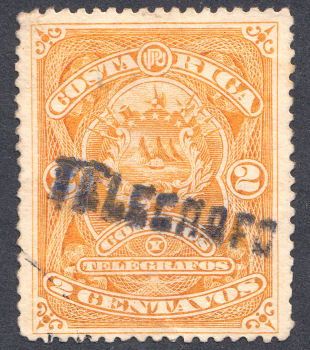 |
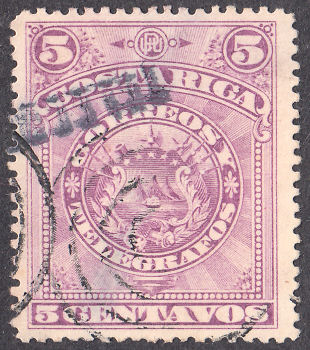 |
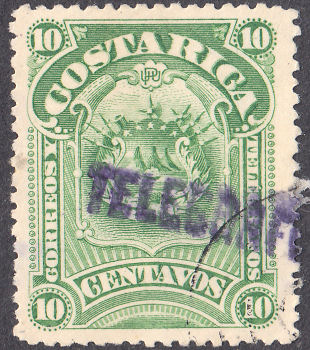 |
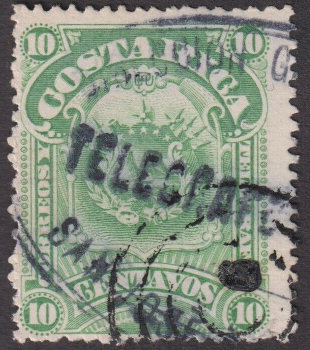 |
| *RH1 - 2c. | RH2 - 5c. | RH3 - 10c. | 10c with San Josè Telegraph cancel. Image courtesy ColettesTreasures. Click image for listing. |
The 'TELEGRAFO' is said to be an overprint, but the San Josè example makes me wonder if it was not simply a cancel. After all, these are Correos y Telégrafos stamps, why would they even need an overprint ?
It is not unusual for telegraph stamps to have two cancels, in fact it is quite normal, one applied by the telegrapher and one by the supervisor after checking.
 |
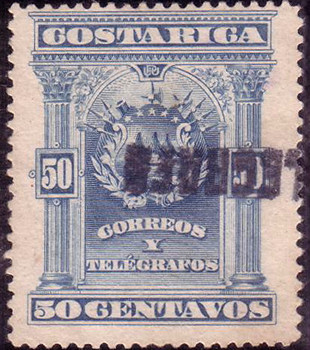 |
| RH4 - 20c. | RH5 - 50c. Courtesy of Rolf Lamprecht. |
| RH # | Hisc. | Type | Description | Mint | Used |
|---|---|---|---|---|---|
| *RH1 | - | 1 | 2c yellow (shades) | - | 20.00 |
| RH2 | - | 1 | 5c red lilac(SG34 ?) | - | 3.00 |
| RH2a | H1 | violet (SG34a) | - | 7.00 | |
| RH3 | H2 | 2 | 10c green (SG35) | - | 4.00 |
| RH4 | H3 | 3 | 20c Indian red (SG 36) | - | 2.00 |
| RH5 | H4 | (4) | 50c blue (SG37) | - | 50.00 |
| RH6 | - | (4) | 1p green | - | - |
| RH7 | - | (4) | 2p brown | - | - |
| RH8 | - | (4) | 5p dark blue | - | - |
| RH9 | - | (4) | 10p brown | - | - |
* I added the 2c value due to the example shown and another. There may
I have added RH6-9 since the higher values are likely to have been used
telegraphically, even though examples with this overprint are not reported.
There are two shades of the 5c, red-lilac and a scarcer violet.
Hiscocks added the following 3 notes:
| Note 1. The overprint was apparently applied manually with a roller. One therefore obtains specimens with the overprint at all conceivable orientations, doubles and, very commonly, beginnings or ends of the next 'TELEGRAFO' on the roller. These have not been listed separately since they would seem to have little philatelic significance. |
| Note 2. Used copies of the above and all later issues up to 1927 are cancelled with a black 'target' of four concentric rings the largest of which is about 2cm in diameter. |
| Note 3. Mint copies do not seem to be known — I have certainly never seen an un-cancelled copy with gum — and some authorities believe that the 'TELEGRAFO' is a cancellation rather than an overprint. The fact remains that the normal 'target' cancellation was also used which makes this explanation less likely. Confirmation one way or the other is needed. |
I understand that after 1895 this cancel was also used as a postal cancellation.
1901 (January) Various designs. Scott says Perf. 12-15½. Michel says Perf. 14, 15, 16 or 15 x 14. Yvert says Perf. 14-15.
The Colon replaced the Peso in 1900.



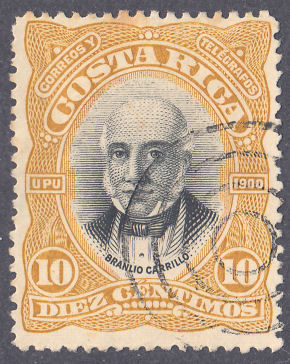
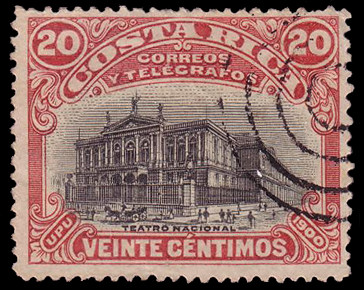
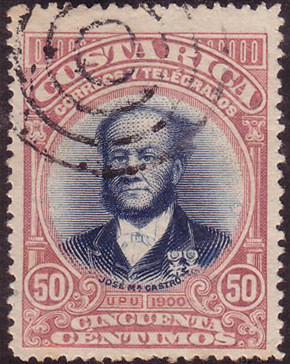
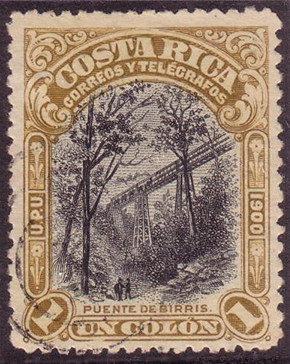
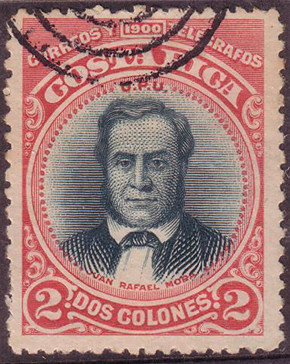

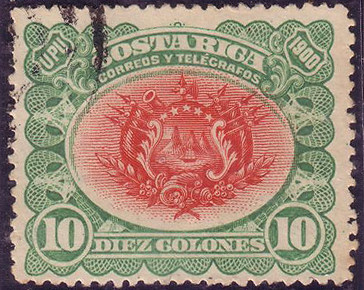
'Correos y Telégrafos' stamps of 1901 with concentric-ring cancels, may have been used postally, but 50c and up are more likely to be telegraphic (20c and above, courtesy of Rolf Lamprecht).
| RH # | Description | Mint | Postally Used |
|---|---|---|---|
| CT21 | 1c green and black | 3.00 | 0.30 |
| CT22 | 2c orange and black | 1.25 | 0.30 |
| CT23 | 5c light blue and black | 3.00 | 0.30 |
| CT24 | 10c ochre and black | 3.00 | 0.35 |
| CT25 | 20c lake and black | 22.00 | 0.25 |
| CT26 | 50c red-lilac and dark blue | 5.50 | 1.00 |
| CT27 | 1C olive-bistre and black | 110.00 | 3.50 |
| CT28 | 2C rose and black | 17.00 | 3.00 |
| CT29 | 5C brown and black | 75.00 | 3.50 |
| CT30 | 10C green and red | 30.00 | 3.00 |
1903 (10 September) Various designs. Scott says Perf. 13½, 14, 15. Michel says Perf. 14 or 15. Yvert says Perf. 14-15.
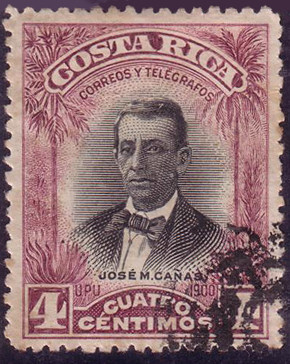
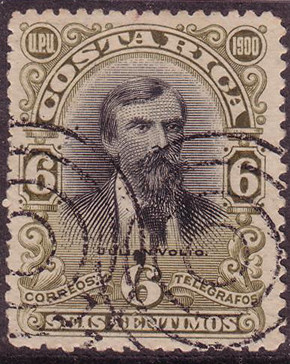
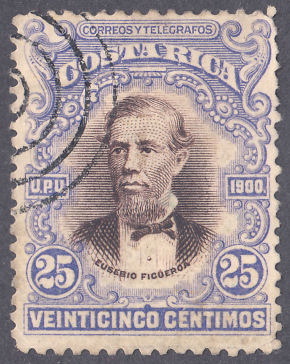
'Correos y Telégrafos' stamps of 1903 with concentric-ring cancels, were probably mostly used postally (4c and 6c courtesy of Rolf Lamprecht).
| RH # | Description | Mint | Postally Used |
|---|---|---|---|
| CT31 | 4c claret and black | 1.80 | 0.75 |
| CT32 | 6c olive-green and black | 8.00 | 4.25 |
| CT33 | 25c blue and dark brown | 17.00 | 0.30 |
1905 CT25 as above surcharged 'UN CENTIMO'.
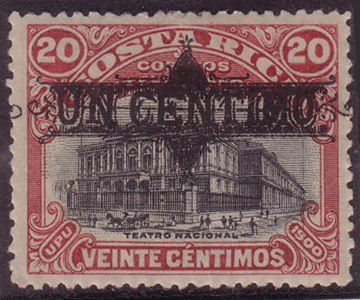
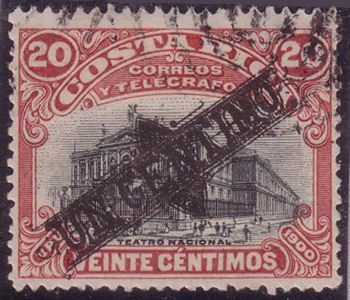
Images courtesy of Rolf Lamprecht.
| RH # | Description | Mint | Postally Used |
|---|---|---|---|
| CT34 | 1c on 20c lake and black | 0.50 | 0.50 |
| CT34a | overprint inverted | 10.00 | 10.00 |
| CT34b | overprint diagonal | 0.50 | 0.50 |
These were probably the last stamps of Costa Rica intended for both Telegraphic and Postal use.
Loose Ends.
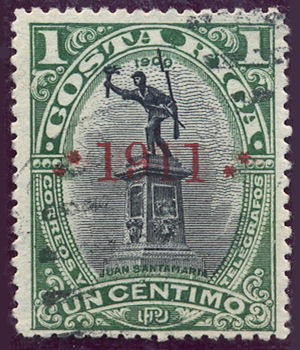
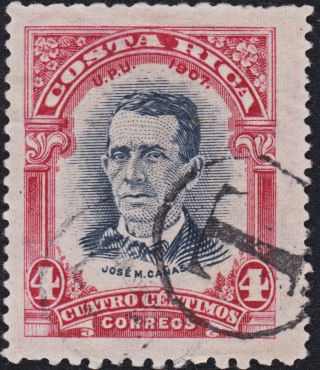
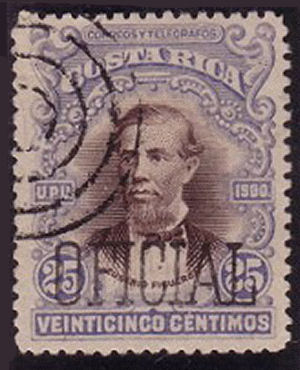
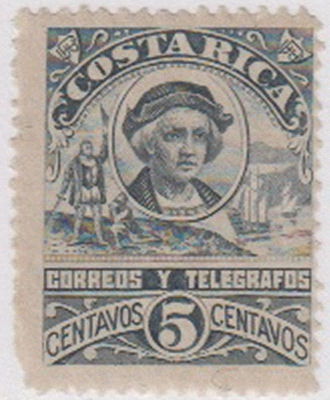
In 1911 CT21 was overprinted to re-validate it. However the intention was almost certainly to revalidate it for postal use
only since there were telegraph stamps in 1911, with apparently no use for a 1c value. Image courtesy of Rolf Lamprecht
The 'T in circle' that was described by vendor as being telegraphic, is not. As with many countries, it is likely that the 'T' stands for 'TAXE' meaning Postage Due. This was purely postal.
Correos y Telegrafos stamps of 1889 to 1903 were overprinted for Official use.
Scott says of all these "normally were not cancelled when affixed to official mail."
It looks like some were, but I have no idea whether such things were used to prepay telegrams. The highest values of these
sets were not overprinted, suggesting they were not intended for telegraphic use. Image courtesy of Rolf Lamprecht
The last stamp, with the Columbus motif was a bit of a puzzle. It is not listed in any of the catalogues that I have. It is gummed, and unusually for Costa Rica is Perf. 12.
Dr. Hector R. Mena of Socorico tells me that it was never issued. He says "Actually the first non emis in the CR listing.
It was printed in 1892 by August Gast Banknote Co of St. Louis, MO in panes of 100 perf. 12,
only in the black color, the reported printing is 50,000 which make it to be common, but probably fewer were placed in the philatelic market, because I see sometimes in eBay asking for $20 or so.
In Socorico one see it auction for around $10, so it is not common. I do not know why it was not released, how many were actually received by the government, etc"
Image courtesy of Bob Bidner.
1907 (28 September). Telégrafos stamps engraved by Ronald A. Harrison of Waterlow Brothers & Layton in London on thin to medium white wove paper.
Sheet watermark. Perf. 14 x 11 or 14 as indicated. Panes of 100 stamps.
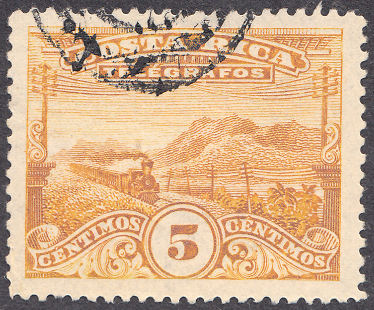 |
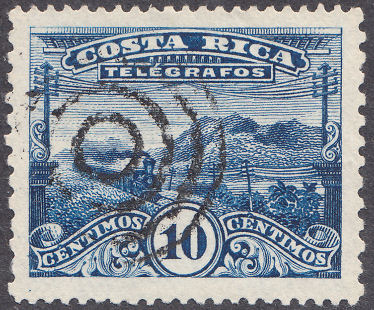 |
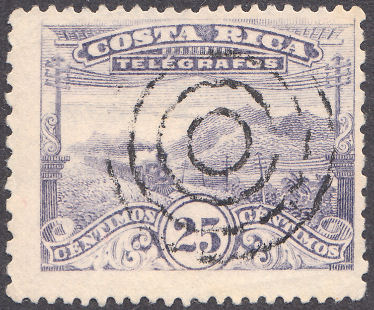 |
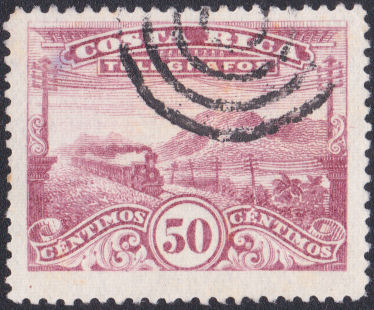 |
| 5c - RH10 | 10c - RH11b | 25c - RH12b | 50c - RH13 |
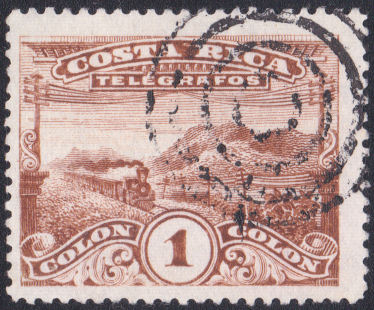 |
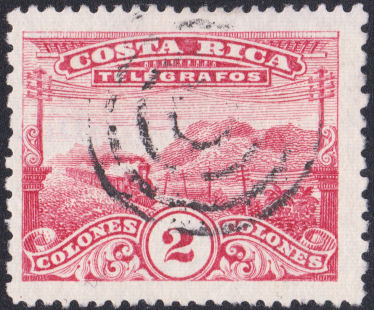 |
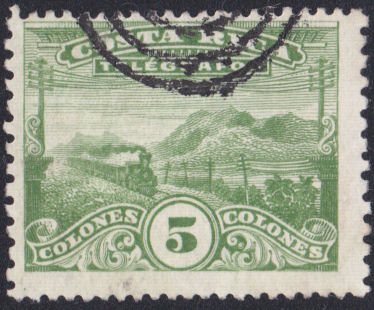 |
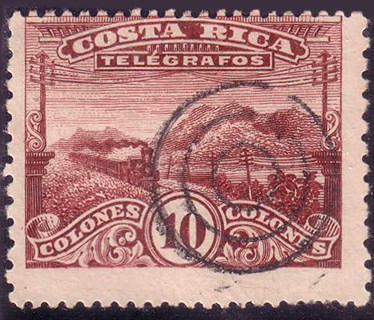 |
| 1C - RH14 | 2C - RH15a | 5C - RH16a | 10C - RH17a - Courtesy of Rolf Lamprecht. |
More images available at paperheritage.co.uk
| RH # | Hisc. | Type | Description | Mint | Used |
|---|---|---|---|---|---|
| RH10 | H5 | 5 | 5c yellow-brown (perf. 14) | 3.00 | 1.50 |
| RH10a | H5a | brownish orange (perf. 14) | 3.00 | 1.50 | |
| RH11 | H6 | 5 | 10c deep blue (perf. 14) | 7.50 | 2.00 |
| RH11a | H6a | blue (perf. 14) | 10.00 | 2.50 | |
| RH11b | H6b | deep blue (perf. 14 x 11) | 3.80 | 1.20 | |
| RH12 | H7 | 5 | 25c slate-violet (perf. 14) | 15.00 | 3.50 |
| RH12a | H7a | yellow brown (error) (perf. 14) | 150.00 | 125.00 | |
| RH12b | H7b | slate-violet (perf. 14 x 11) | 10.00 | 2.00 | |
| RH13 | H8 | 5 | 50c carmine-red (perf. 14) | 75.00 | 10.00 |
| RH13a | H8a | perf. 14 x 11 | 4.00 | 3.50 | |
| RH14 | H9 | 5 | 1C brown (perf. 14) | 10.00 | 2.50 |
| RH14a | H9a | perf. 14 x 11 | 40.00 | 15.00 | |
| RH15 | H10 | 5 | 2C carmine (perf. 14) | 10.00 | 1.50 |
| RH15a | H10a | perf. 14 x 11 | 40.00 | 12.00 | |
| RH16 | H11 | 5 | 5C green (perf. 14) | 75.00 | 60.00 |
| RH16a | H11a | perf. 14 x 11 | 35.00 | 2.50 | |
| *RH16b | - | perf. 11 (no gum) | - | - | |
| RH17 | H12 | 5 | 10C brown-lake (perf. 14) | 100.00 | 75.00 |
| RH17a | H12a | perf. 14 x 11 | 75.00 | 3.00 |
* I added this due to the H. R. Mena specialized catalogue.
Hiscocks added the following 2 notes:
| Note 1. No. 7 tends to discolour with exposure and take on a more reddish hue. |
| Note 2. See also Nos. 20 to 25 which are of the same design. |
1910 (15 February). Engraved on white wove paper by the American Bank Note Co. No watermark. Perf. 12. Panes of 100.
These stamps were discontinued for telegraphic purposes on October 10, 1910. Remaining stocks of these and the 1907 issue, were overprinted for other uses.
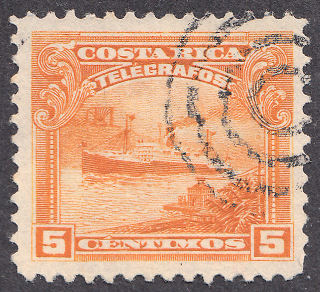 |
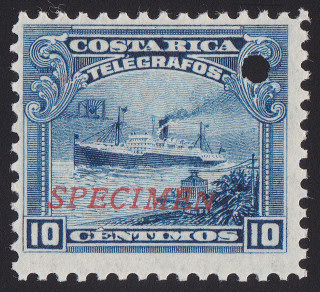 |
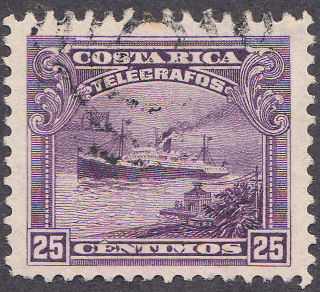 |
| 5c - RH18 | 10c - RH19 specimen Only 5c, 10c and 25c like this. |
25c - RH20 |
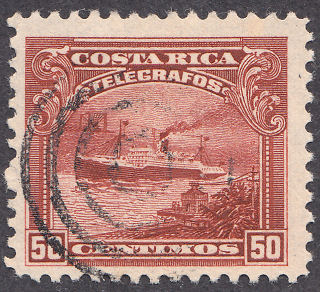 |
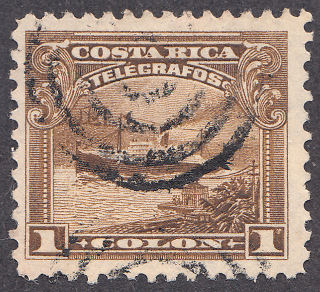 |
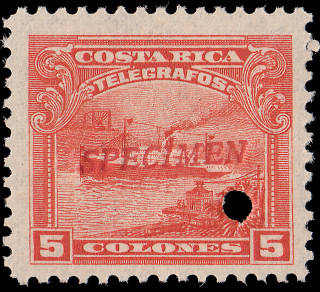 |
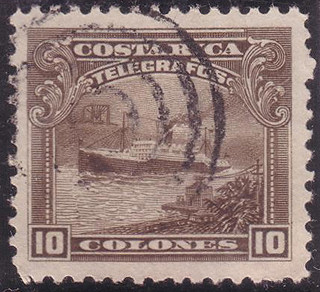 |
| 50c - RH21 | 1C - RH22 | 5C - RH23 specimen All values except 10c like this. |
10C - RH24 - Courtesy of Rolf Lamprecht. |
Specimens of the set were prepared overprinted in red and with a punch hole.
There were two formats of the specimens, one with the hole above 'SPECIMEN', known for the 5c, 10c and 25c, the other with the hole below, for all the rest except the 10c.
There are thus two types of 5c and 25c, but one type of each of the other values.
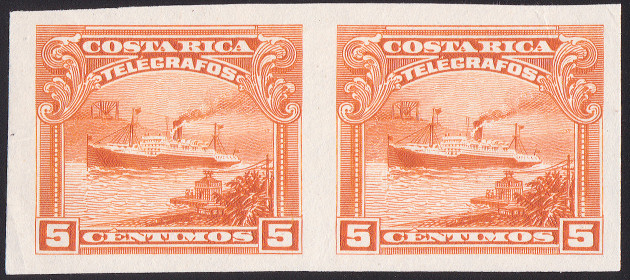
I also have a set of these imperf. and another set of pairs imperf., all unused (no gum).
In each case, the low values up to 25c are on white, ungummed paper and the high values of 1p to 10p are on white ungummed card.
According to Dr. Hector R. Mena, the 5c, 10c and 25c also exist as horizontal gutter pairs.
| RH # | Hisc. | Type | Description | Mint | Used |
|---|---|---|---|---|---|
| RH18 | H13 | 6 | 5c orange (shades, 800,000) | 3.80 | 2.00 |
| RH19 | H14 | 6 | 10c dark blue (300,000) | 5.00 | 2.00 |
| RH20 | H15 | 6 | 25c deep lilac (1,000,000) | 5.00 | 2.00 |
| RH21 | H16 | 6 | 50c brown lake (100,000) | 10.00 | 10.00 |
| RH22 | H17 | 6 | 1C brown (50,000) | 10.00 | 2.50 |
| RH23 | H18 | 6 | 5C scarlet (25,000) | 25.00 | 3.00 |
| RH24 | H19 | 6 | 10C deep brown (25,000) | 40.00 | 3.80 |
Hiscocks added the following note:
| Note. Nos. 5, 6 and 8 to 19 were surcharged with new values and used as provisional postage stamps in 1911-12 (SG94-108). The use of these provisionals for telegraphic purposes is not known. |
1927 (30 January). Design of 1907 engraved on white wove paper. No watermark. Perf. 12½
Discontinued sometime before 1930.
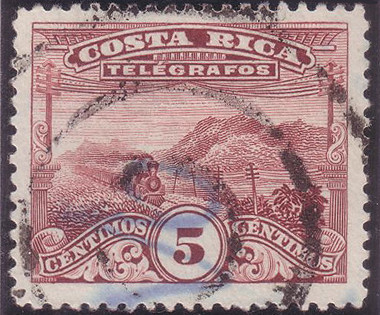 |
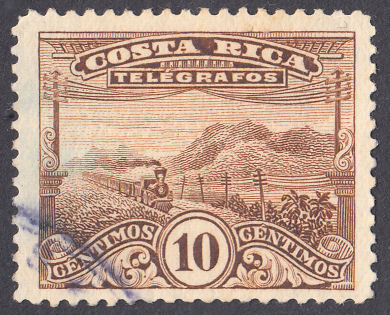 |
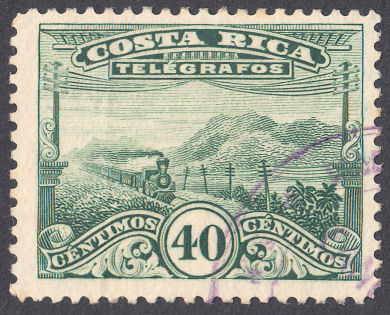 |
| 5c - RH25 - Courtesy of Rolf Lamprecht. | 10c - RH26 | 40c - RH27 |
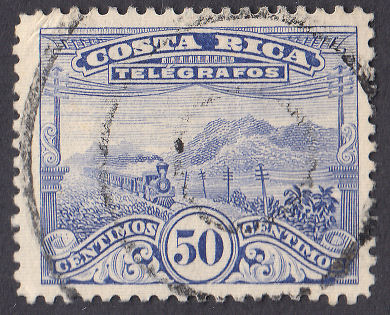 |
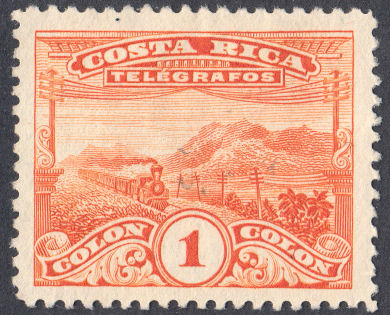 |
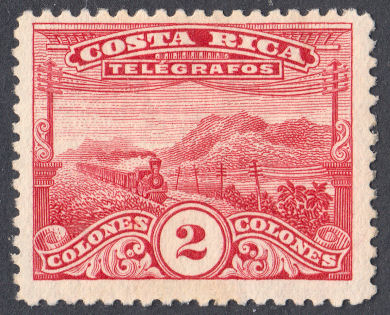 |
| 50c - RH28 | 1C - RH29 | 2C - RH30 |
| RH # | Hisc. | Type | Description | Mint | Used |
|---|---|---|---|---|---|
| RH25 | H20 | 5 | 5c brown-lilac (500,000) | 5.00 | 2.50 |
| RH26 | H21 | 5 | 10c dark brown (1,000,000) | 2.50 | 1.50 |
| RH27 | H22 | 5 | 40c green (3,000,000) | 3.80 | 2.00 |
| RH28 | H23 | 5 | 50c blue (1,000,000) | 3.80 | 3.80 |
| RH29 | H24 | 5 | 1C orange (500,000) | 7.50 | 7.50 |
| RH30 | H25 | 5 | 2C carmine (500,000) | 15.00 | 15.00 |
Hiscocks added the following note:
| Note. Nos. 21 to 24 were overprinted 'CORREO AERO' and used for airmail postage in 1930-32 and again in 1945-46 (SG 182-5, 193, 402-4). |
Sometime in the lifespan of this series a new cancel started to be used:
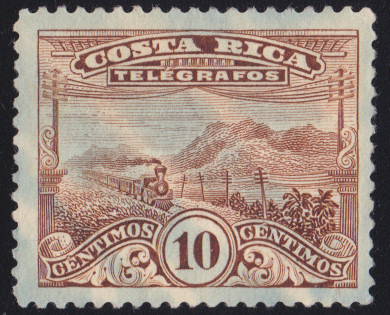
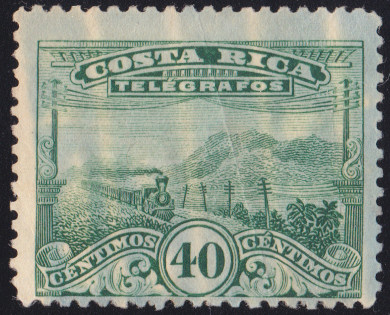
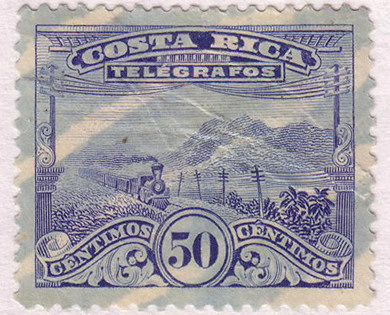
The cancel takes the form of pale dull-green streaks across the stamp which are not always very visible.
These stamps were discontinued for telegraphic purposes around 1930 and many were overprinted for other purposes such as Air Post.
Perhaps these were also used for some other purpose without overprinting. Parcel Post for example. (50c courtesy of Ralph Lamprecht)
Anyone know the purpose of this style of cancel ?
For The Telegrams used, see the section on Telegram Seals.
Telegram Seals.
A range of different seals were used on telegrams of Costa Rica.
This half sized image shows a sample of them.
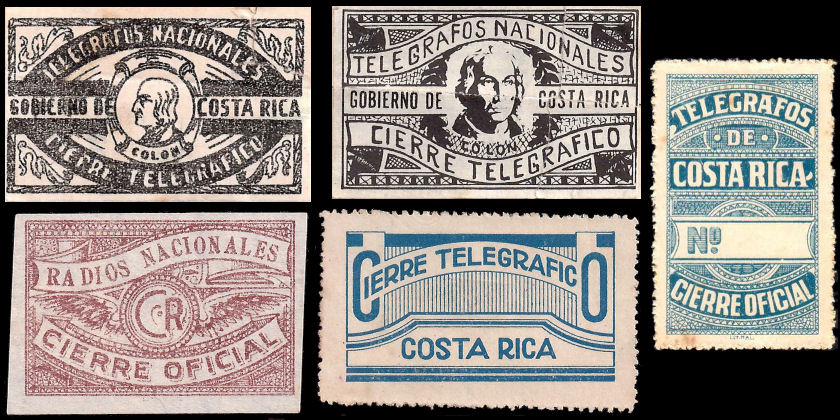
Steve Hiscocks made a start on cataloguing seals of the world in a book he published in 2007.
It was his hope to update it later, but unfortunately that was not to be.
His original book can be viewed at
Telegraph Seals: A World Catalogue. There are links from the pages to my updates.
Alternatively you can view the latest page for Cost Rica.
